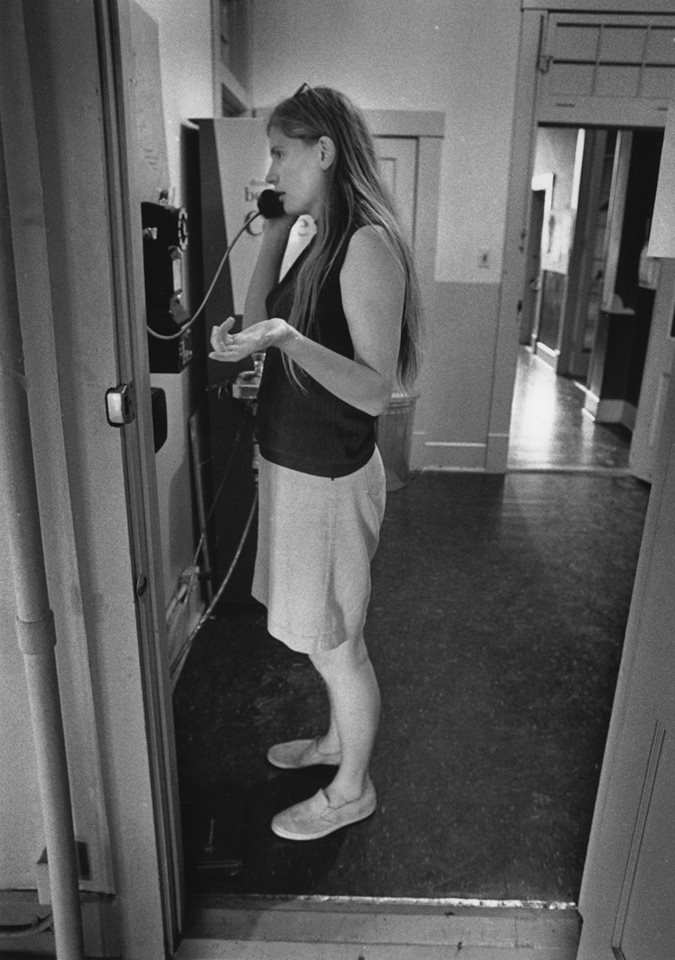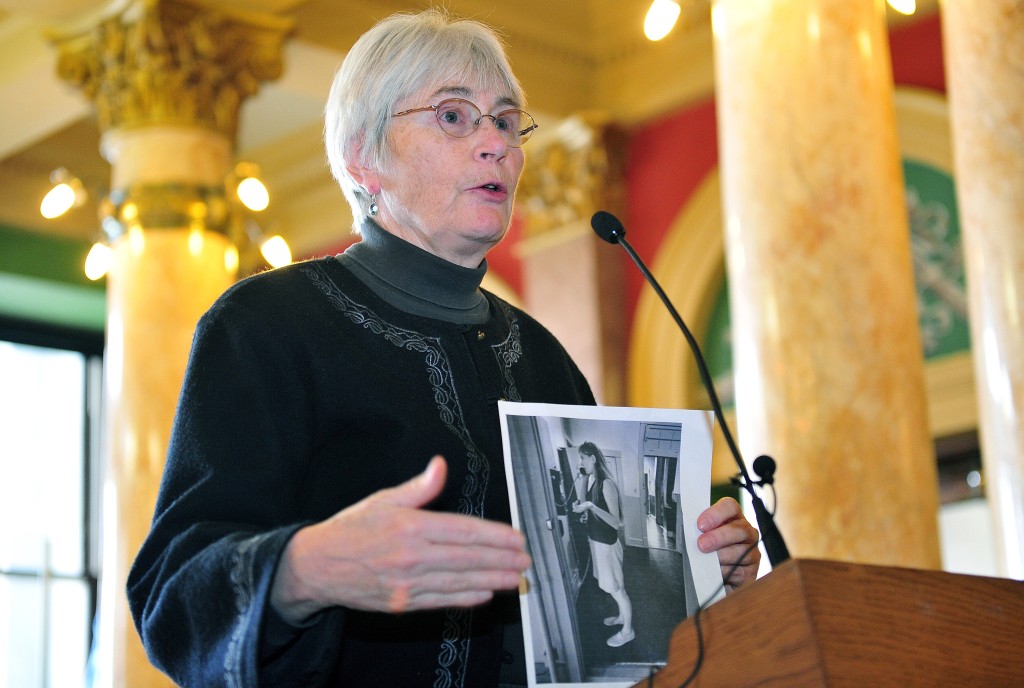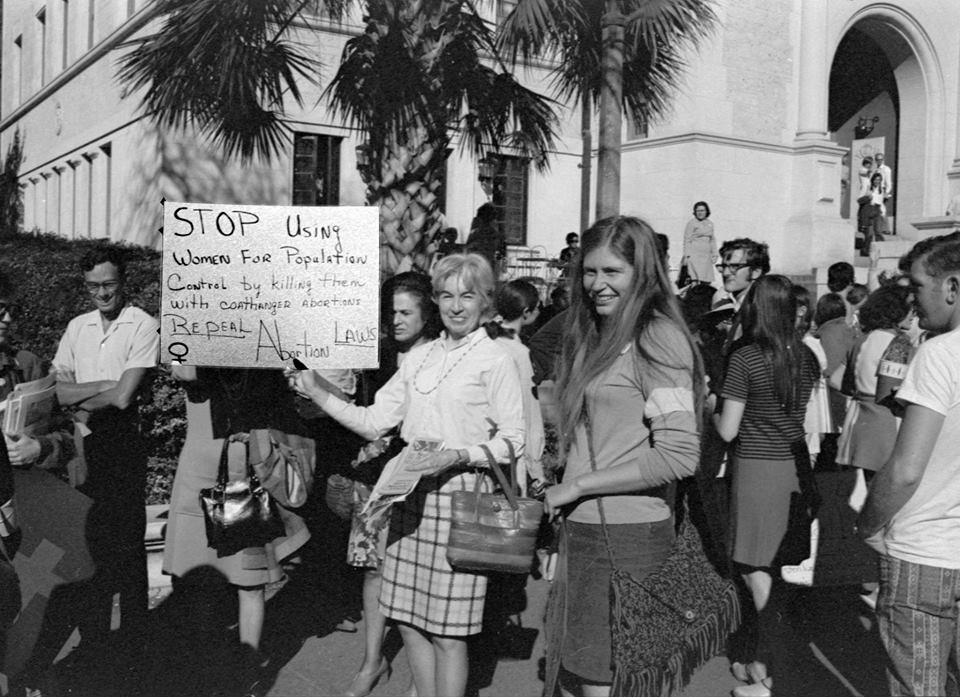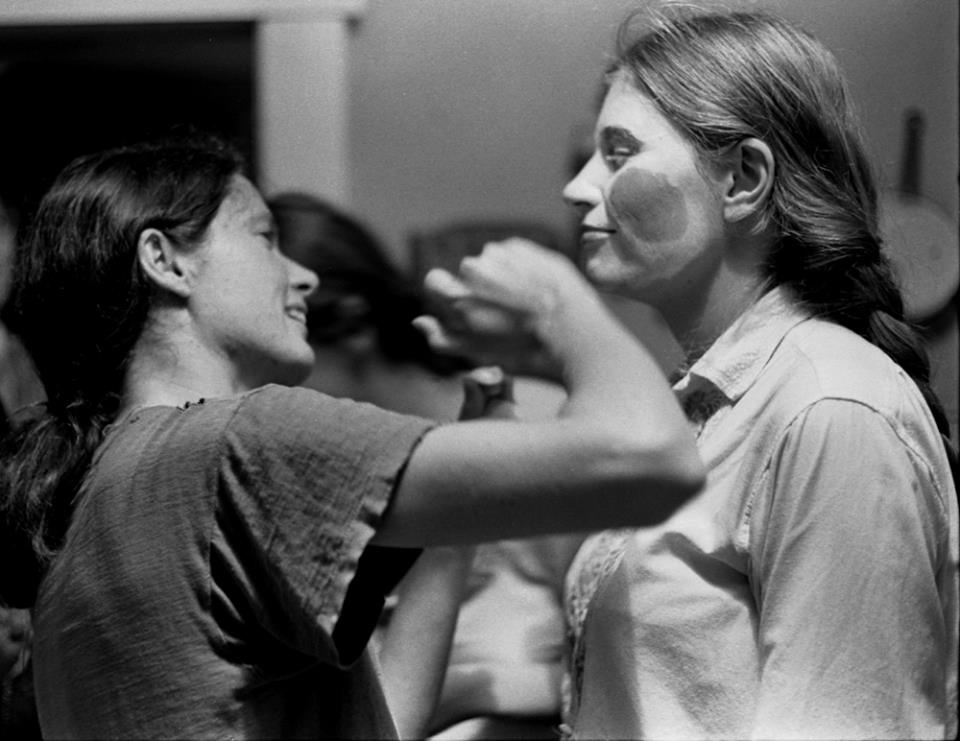Judith Hart Smith, 1944-2013

Judy Smith answers the women’s reproductive rights hotline at the University YMCA, next door to the Rag office, in Austin, Texas, 1970. Photo by Alan Pogue /The Rag.
Judy Smith was the face of feminism
at The Rag for many years.
Judy Smith, who had a great and lasting impact on all who knew and worked with her, died November 6, 2013, in Missoula, Montana, after a lengthy battle with cancer. Alice Embree knew Judy from the Austin women’s movement and, along with Phil Prim and photographer Alan Pogue, worked with her at Austin’s underground newspaper, The Rag.
Judy Smith was the face of feminism at The Rag for many years. She was tall, athletic, smart, and comfortable with leadership. She was a driving force for women’s liberation and a mentor to many women. Sarah Weddington in her book, A Question of Choice, credits Judy Smith as being instrumental in the decision to take Roe v. Wade to court. The case resulted in the 1973 Supreme Court decision protecting choice.
Judy Hart Smith passed away on November 6, 2013 in Missoula, Montana, at the age of 69. She graduated from Brandeis and served in the Peace Corps in Nigeria before coming to Austin to pursue a doctoral degree in molecular biology at the University of Texas.
Between 1968 and 1973, Judy and her sister, Linda, were at the center of a Rag collective that embraced feminism, disdained hierarchy, and operated by consensus, not titles. Mastheads and bylines often reflected first names only, and Judy’s writing covered a vast array of topics, including Fort Hood, urban renewal, fair housing, apartheid, birth control, vasectophophia, the energy crisis, and the coup in Chile.
Judy helped launch the Austin Women’s Center and a women’s birth control hotline. The iconic photo of Judy Smith by Alan Pogue (above) captures her responding to a call in the hallway of the “Y” at 2330 Guadalupe where the Rag offices were located. The hotline was an experience that made Judy acutely aware of two issues women faced — access to birth control and access to safe, legal abortions. It was a time when abortions were illegal, dangerous and often required a secretive trip across the Mexican border.
Judy moved to Missoula in 1973 where her feminism and passion for social justice continued to blossom over the next four decades. She helped establish the Blue Mountain Woman’s Clinic, providing women with reproductive health choices. She was a teacher at the University of Montana School of Social Work, and taught assertiveness training at the Women’s Resource Center.
She helped create several organizations that empower women with training and access to business incubation grants. She was a founder of HomeWord, a community development organization that promotes home ownership and affordable housing. She helped organize Montana Women Vote, a coalition encouraging low-income women to register and vote, and was on the steering committee of Montana Women Pipeline Project, an organization similar to Emily’s List, that works to elect progressive women in Montana.

Judy Smith holds Alan Pogue’s iconic photo of her doing reproductive rights counseling at the University of Texas YMCA. Photo by Eliza Wiley / Helena (Montana) Independent Record.
Judy Smith was also a frequent commentator on Montana Public Radio. You can listen to their tribute to Judy at this link.
None of Judy Smith’s Montana accomplishments seem surprising given her larger-than-life impact in Austin and on The Rag. Largely due to Judy’s influence, The Rag not only survived the challenges of women’s liberation, but also thrived as an incubator for women’s leadership.
Barbara Hines is a co-director of the Immigration Clinic at the University of Texas Law School and a national renowned expert in the field of immigration law. She worked with Judy Smith at The Rag. “I’ve thought a lot about her influence lately,” Barbara told me. “If it weren’t for Judy Smith, I don’t think I would be the person I am today.”
Judy Smith had a profound impact on the lives of many women in Austin. She continued for another 40 years to expand horizons for women in Montana.
[Alice Embree, a contributing editor to The Rag Blog, is a long-time Austin activist, organizer, and member of the Texas State Employees Union. A veteran of SDS and the women’s liberation movement, Alice is a former staff member of the North American Congress on Latin America (NACLA) and of underground newspapers The Rag in Austin and RAT in New York. She now co-chairs the Friends of New Journalism. Read more articles by Alice Embree on The Rag Blog.]
Judy Smith was a tall, strong, beautiful,
and self-confident woman.
I first encountered Judy Smith about a year before we actually met. She was speaking at an SDS internal education series where SDS members would learn from the experience of their own membership. She was a tall, strong, beautiful, and self-confident woman who presented her material with the skill of a professional. Even after one brief evening, she made an indelible impression.
In September 1969 I joined the Rag staff. Judy Smith and her sister Linda were already there. I got to know Linda first, as she was the office manager, and for the first time in my adult life I had plenty of free time.
As I got to know Judy better in the coming months, the first impression described above broadened and strengthened. She was superb with group dynamics, never striving for dominance, but always making sure her views were heard. I later learned that she, more than any other person, had ended the sexism and male dominance which had been present in the Rag’s early days.
I learned of her background bit by bit, some things quickly and others as recently as last month. She had a full scholarship to Brandeis University, where she majored in chemistry and, in her spare time, led the women’s basketball team to an undefeated season in her senior year. Sarah Weddington, in her book, A Question of Choice, relates the story of how a chemistry professor refused to give Judy a recommendation for graduate school at UT Austin because, he said, “I don’t believe in giving recommendations to women.” This was a wake up call for her to what women faced in academia and in business.

Judy Smith, at right, at the first Texas statewide women’s reproductive rights conference at the U.T. Student Union, 1971. Holding the sign is Judy’s mother and, on the left with arms folded, is Phil Prim. Photo by Alan Pogue / The Rag.
She spent a year in the Peace Corps in Nigeria before being airlifted out because of the outbreak of a Nigerian civil war. There she witnessed horrible things such as headless bodies being hauled off in trucks. She didn’t speak of these events for a long time after she returned.
Besides The Rag, her other major activity was organizing Women’s Liberation, the first feminist group in Austin. Although job discrimination was a major impetus for the group’s formation, it was the issue of abortion rights that soon became front and center.
Their Birth Control Information Center, located in a corner of the Rag office would refer women wanting an abortion to one of the few doctors in Texas willing to perform them. If no Texas doctor was available, they would travel to Nuevo Laredo to scope out clinics in Mexico. If the clinics were safe, dependable, and reasonably priced, they would refer women to them. The possibility of being charged with an accessory before the fact of a felony must have occurred to them, but they did it anyway.
When I read in Sarah’s book that Judy was rather quiet in meetings, preferring to listen rather than to talk, I wondered at first if she wasn’t talking about some other person. The one I knew never hesitated to make her views known in Rag meetings.
Upon further consideration, however, I realized that her restraint in the women’s meetings was a result of a psychological astuteness for which she did not always get credit. Some of these women were just emerging from a culture where girls were seen and not heard, and an aggressive presence by one of their own might have been intimidating.
Of course her greatest accomplishment at this time was, with help from Jim Wheelis and Sarah’s husband, Ron, convincing Sarah to move her practice to Dallas, find a plaintiff who wanted an abortion, but could not get one, and file a case in federal court. The full story can be found in Sarah Weddington’s book.
Judy moved to Missoula, Montana, in 1973 and accomplished many things in her 40years there. Her sisters, friends, and colleagues, in Montana and in Austin, will long remember this wonderful life that ended too soon.
Rest in peace, Judy Smith. You will never be forgotten.
[Phil Prim was a peace and justice activist in Austin and a mainstay at The Rag for much of its history.]



















Although we never met, Judy was an inspiration to me after hearing many stories about her from Rag contributors and watching interviews from the 2005 Rag Reunion filmed by People’s History in Texas. Here is an excerpt from my undergraduate thesis on the Rag describing Judy:
“Everyone who was working on The Rag during the emerging feminist period in the late sixties and seventies in Austin describes Judy Smith as the undisputed “moving force” of not just feminist issues, but every other political issue that mattered in The Rag at that time. She was confident and sociable, strong-willed, and smart (Ph.D. student in Chemistry). Judy was also 5’10,” beautiful, blonde, and had been, according to Phil Prim, “captain of the women’s basketball team at Brandeis University where she had a full scholarship and they had an undefeated season,” so she possessed a commanding physical presence as well. Bill Meacham calls her the “Valkyrie Mother.” She preferred to draw the connections between issues rather than separate them, and was politically more interested in doing than in talking.
Judy came to Austin from San Francisco after much persuading on the part of her older sister, Linda, who would mail issues of The Rag to entice her to move back to Texas. When she first arrived, Judy was disappointed to find that the same ideological factions that she viewed as distracting from progress in San Francisco also existed to a less extreme degree in Austin. She originally fell in with the Progressive Labor (PL) crowd because they appeared to be a group that was going out into the community and “actually doing political work.” She soon found them to be too ideologically extreme, however, which was made evident by one argument in particular between Judy and a certain PL advocate who also contributed to the Rag. He exploded at Judy, calling her “the problem” and “bourgeois middle class” when she mentioned she was going to attend a symphony. “Never being one to let someone attack me, I told him what I considered of that, and if that was what this group was going to be then I wasn’t very interested in this group because it was very narrow-minded and ideological and would never get anything done anyway.”
Judy then devoted her energy to The Rag and the Austin Women’s Liberation Movement, inspiring Rag women like Suzanne Gott, who would go on to personally inspire other women like Glenn Scott, and so the movement grew.”
Thank you for adding to these remembrances of Judy. And thank you for your wonderful thesis on The Rag in its later years – a period that hasn’t seen as much recognition in print. May the story and struggle continue.
My extended thoughts about Judy;
Judy Smith was one of the most influential people in my life. I wouldn’ be where I am today– teaching at a major law school– if I hadn’t met her in a philosophy class at UT in 1969. She invited me to the Rag and to a women’s liberation consciousness raising group; my life changed forever. We began the Women’s Birth Control Counselling Center at the University Y, which later connected us with Sarah Weddington, and the ensuing Roe v Wade decision. Judy’s charismatic sense of self and her clear political vision were legendary. Yet she always encouraged others, including me, to grow and take leadership roles, particularly in the fledgling women’s movement. I will always be grateful to her and I will miss her.
I just learned of Judy’s death in a very circuitous way. As some of you will remember, Judy Walther, David Mahler, Rita Starpattern and I lived downstairs from Judy and Jim on Oakland Ave. Even then I considered myself fortunate to live in the same house as Judy which meant many dinners, cups of coffee, conversations and of course getting things done, starting organizations and thinking in new ways. Judy was one of the most remarkable women I’ve ever known and I can still say that after more than 40 years. My guess is that everyone who knew her would say the same thing. As much as she did not believe in hierarchies of leadership, she was a leader and teacher because of her amazing mind and the clarity of her thinking. She wanted us to move forward with her—side by side; but so often she led the way.
Thank you for providing valuable information for my short piece about Judy Smith for the “Women’s History Matters” project, which you can view at http://montanawomenshistory.org/feminism-personified-judy-smith-and-the-womens-movement/#more-1537